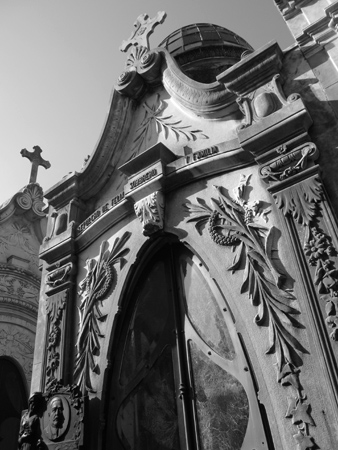
Documenting Recoleta Cemetery in Buenos Aires since 2007
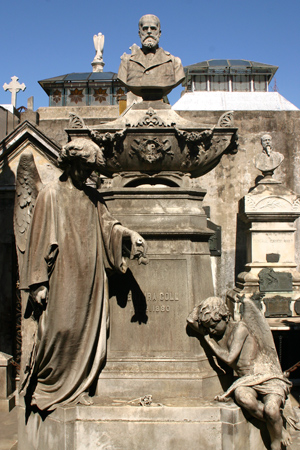
Hidden among a series of short rows, Ventura Coll gets little attention these days & even fewer people remember who he was. An inscription on the back side made the search for background info easier:
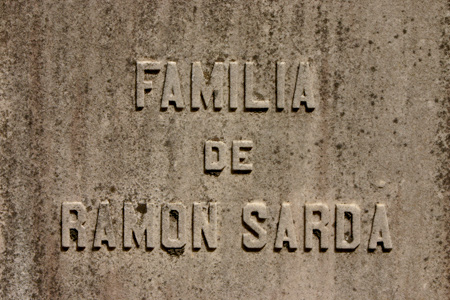
Thanks to some helpful people at the Province of Santa Fe historical society, I learned that Ventura Coll was a doctor there, somewhere in the province… that’s all anyone knew about his life. But Ventura’s sister, Victoria Coll, married Joaquín Marull & had a daughter named Delfina. Delfina married Ramón, so that’s how the Sardá line also wound up in Recoleta Cemetery with the Colls.
All these last names are Catalán, & Sardá was also a doctor. Seems that Coll stuck to a tight social circle of Catalan immigrants. The historical society also provided me with a wonderful photo with Ventura Coll (left) & Ramón Sardá (right). The bust on the grave is remarkably accurate:
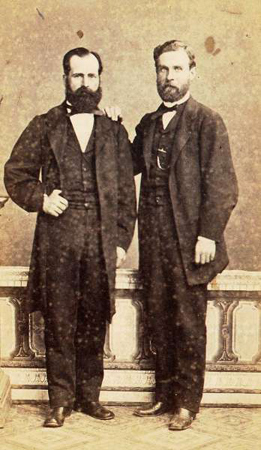
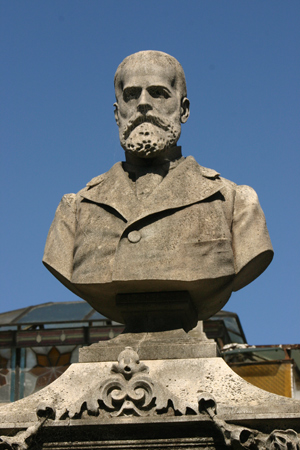
The statue of the boy angel may seem familiar to regular readers of this blog because the same statue also decorates the Francisco Gómez family vault:
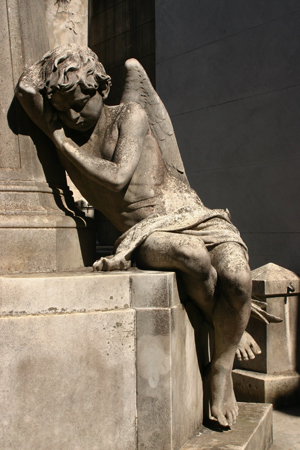
Delfina & Ramón Sardá had no children, so it’s interesting to note that they donated money to establish a maternity hospital in Buenos Aires. Opened in 1934 in the neighborhood of Parque Patricios, the building is textbook Art Deco & one of the most important public hospitals in the city. With over 6,000 births per year, no wonder it was immortalized in the 1954 movie “Mercado de Abasto” with Tita Merello & Pepe Arias:

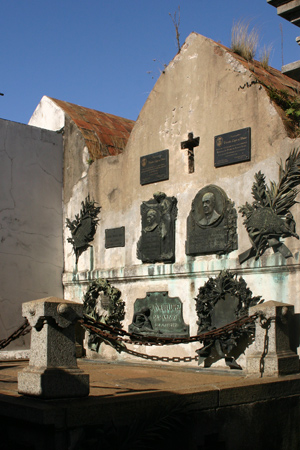
With today marking the 198th anniversary of Argentina’s declaration of independence, there’s no better time to discuss the author of the national anthem.
Born in Buenos Aires in 1785, Vicente López y Planes participated in every important event leading to the birth of the new nation. His political career began as secretary of the short-lived First Triumvirate, & he maintained a close friendship with Manuel Belgrano.
As the fight for independence continued in other parts of Argentina, López y Planes was requested to write the lyrics for a military march which later became the national anthem. First played in 1813 at the home of Mariquita Sánchez de Thompson then publicly debuted on May 25th that same year, the song bitterly attacked Spain… a normal reaction given that they were at war. The anthem was later changed to remove the nasty references to Spain, & a shorter version was officially adopted since the original ran a bit long:
Mortals! Hear the sacred cry:
Freedom, freedom, freedom!
Hear the noise of broken chains,
see noble Equality enthroned.
Rises to the heights of the Earth
a new and glorious nation,
its head crowned with laurels,
and at her feet lying a Lion.Chorus:
May the laurels be eternal,
the ones we managed to win.
Let us live crowned with glory…
or swear to die gloriously.
As minister under the first President Bernardino Rivadavia, López y Planes took charge of the 1827 interim government when Rivadavia resigned. After his one-month presidency ended, he maintained an active role in national politics mainly in the judiciary branch. Other intellectual pursuits found López y Planes as part of a literary society founded by Marcos Sastre.
López y Planes died in 1856, & his crypt was declared a National Historic Monument in 1946. Simply decorated with four corner posts connected with chains, numerous plaques occupy the walls of neighboring tombs. New plaques are generally made of marble instead of bronze or other metals:
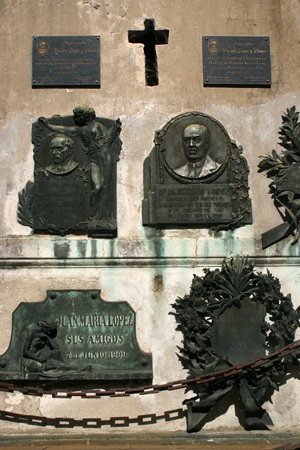
The full text of both the original & modified versions of the Argentine national anthem can be found on Wikipedia along with an instrumental recording.
Leave a CommentA single Jewish tomb reminds visitors of the multi-denominational character of Buenos Aires. Although it sits unoccupied today, this iswas the only tomb in Recoleta Cemetery decorated with a Star of David:
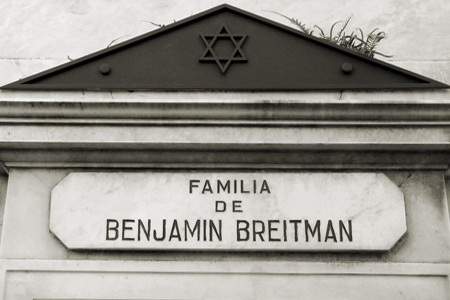
When the cemetery was founded in 1822, the majority of the city’s population was Catholic so it was blessed accordingly. During the presidency of Bartolomé Mitre the blessing was officially removed when he insisted that a prominent member of the Masonic Order be buried there. Or so the story goes. These days, all public cemeteries in Buenos Aires are non-denominational. However given the conservative class of the families present, Recoleta Cemetery remains 99% Catholic.
Not much is known about Benjamín Breitman or how he came to purchase a plot, but the history of Jewish burials in Argentina began with the establishment of the community in Argentina. Founded in the 1860s the Templo Libertad on Plaza Lavalle may not be the oldest synagogue in Buenos Aires, but it was the most important for early Jewish immigrants:
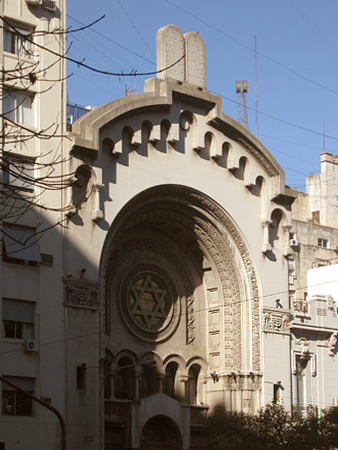
Jewish tradition foregoes ostentatious burials, given that all are equal after death. The largest non-Catholic cemetery during the early years of the Jewish community in Buenos Aires was the Cementerio de Victoria (now Plaza 1º de Mayo). Sponsored mainly by the Protestant community & 50% funded by the UK, Jews & Protestants were buried together at the same location. Popularly referred to as the Cementerio de los Disidentes, it filled to capacity during the 1871 yellow fever epidemic. Back then if you weren’t Catholic, then you must be a dissident.
The Jewish community had an opportunity to claim part of Chacarita Cemetery when it opened but opted to wait for their own burial ground. In 1912 the Cementerio de Liniers opened (actually just outside the city limits of Buenos Aires) exclusively for Jews & was mainly for those of Ashkenazi descent. Being buried there still remains a sign of high status within the community. Jews of Moroccan descent—many referred to as “impure” based on their connections with the mafia—opened a cemetery south of Buenos Aires in Avellaneda. It is currently closed. In 1936, another cemetery was opened for poorer Jews in Tablada & the newest cemetery in Ciudadela is typically for those of Sephardic descent. All these cemeteries are closed to visitors.
Jewish funeral rites are unique but unfortunately beyond the scope of this blog. Many thanks to Leonor Slavsky for sharing her investigations at talks sponsored by the Instituto Histórico.
—————————————————
Update (30 Jul 2010): Earlier this year the plaque with the Star of David on the Benjamín Breitman family tomb was removed. Reasons are unknown for the removal, but Marcelo unexpectedly found another vault with possible Jewish symbolism.
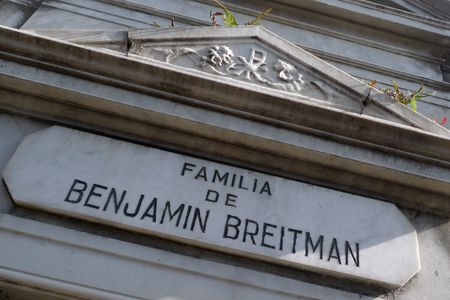
Update (18 mar 2011): According to a comment below, the plaque fell from the tomb from neglect & is now stored in the Administration office for safekeeping.
Update (31 May 2013): According to the Find A Grave website, Benjamín Breitman passed away on 04 Mar 2012 & was buried in his family tomb the following day. Thanks to Raúl for the info!
13 Comments